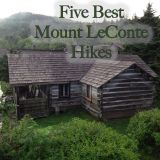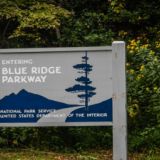The Cades Cove Experience in Great Smoky Mountains National Park
The 6,800-acre valley comprising Cades Cove, one of the most visited areas of the park, provides a glimpse of a bygone mountain lifestyle. Travel in your car or truck (no RVs or commercial vehicles) on a one-way, 11-mile paved loop road. Sightings of deer, turkeys, black bears, coyotes, ground hogs, raccoons, butterflies, and other animals are exciting and common.
Those seeking an out-of-the-vehicle experience may enjoy cycling the loop or hiking the many trails found in Cades Cove. One of the most popular hikes is to the picturesque Abrams Falls. Midway of the loop, the Cades Cove Visitor Center, home to the John Cable Grist Mill, the Gregg-Cable House, a Cantilever Barn and other farm buildings, is the perfect place to pause. Grassy meadows and banks of the babbling stream provide great picnic venues. Graveyards, located beside several historic churches in the cove, bear mute testament to early residents.
Cades Cove Need to Know
- The path into the cove is open from sunrise to sunset year-round.
- It can sometimes take more than four hours to complete the 11 mile one-way loop during the busy summer and fall seasons, and on most weekends. Sparks Lane and Hyatt Lane offer shortcuts out of the cove.
- The road is closed to motor vehicles each Wednesday each May to late September.
- The loop is closed to cars until noon each Saturday in December to allow bicyclists and hikers a quiet journey. Bike rentals available at the Campground Store. Enjoy an ice cream cone from the Campground Store too!
- Cades Cove Riding Stable offers guided trail rides on horseback, hayrides, and carriage rides from early March through late November. For more information and prices, visit CadesCoveStables.com or call 865-448-9009.
- A self-guiding booklet is available for a small fee at the Orientation Shelter at the beginning of the loop.
- Cades Cove Picnic Area has charcoal grills for cooking or consider packing a basket for a picnic in the cove. Don’t forget a blanket and chairs.
- Please pack out all your trash!
- Bring binoculars for optimal wildlife viewing.
Camping in Cades Cove Year-Round
- Cades Cove Campground features 159 sites and accommodates tents and RVs up to 35-feet. It is open year-round and offers a Camp Store. For reservations, call 877-446-6777 or visit www.recreation.gov.
- The Anthony Creek Horse Camp is located nearby and offers access to the back country. To reserve a site, call 877-446-6777 or visit www. recreation.gov.
Hiking in Cades Cove
There are many miles of trails for day hikers, backpackers, and horses that can be accessed in Cades Cove. Here are a few of our favorites.
Abrams Falls Trail – 5 miles roundtrip to waterfall
The Abrams Falls trailhead is located between signposts #10 and #11 about five miles into the one-way Cades Cove Loop Road. This popular trail to the picturesque falls, which drop 20-feet into a deep pool, is a great hike in any season. Please don’t climb on the slippery rocks around the falls or swim in the pool (the undertow has caused drownings!) Beautiful evergreen rhododendron line the trail before it passes over a low pine ridge which offer a wonderful display of spring wildflowers. Beyond the falls, the trail continues another 1.7 miles to intersect with Hannah Mountain and Hatcher Mountain Trails which lead to an area of the gorge where an EF4 tornado hit in April 2011. In some places every single tree was knocked down.
Cades Cove Nature Trail – Half-mile roundtrip
The Cades Cove Nature Trail is found at signpost #13 on the Loop Road. This short walk in the woods is a nice spot to stretch your legs any time of the year.
Gregory Bald Trail – 9 miles roundtrip to Gregory Bald
Gregory Bald is a 10-acre grassy meadow where in June you’ll discover a display of native flame azaleas that you won’t find anyplace else in the world. For years the azaleas have hybridized to form an array of colors in shades of red, orange, yellow, pink, and white. In August, Gregory Bald is full of ripe blueberries. However, any time of the year, the views from Gregory Bald are remarkable. On the way to the top, you’ll hike through an old-growth forest that contains some large hemlock trees. To access the Gregory Bald Trail, take the Cades Cove Loop to the Visitor Center at Cable Mill area. Just past the main parking lot, follow the signs to Forge Creek Road (will be on your right) that will take you to Parsons Branch Road. Once on Parsons Branch Road, drive 3.3 miles to Sam’s Gap where the Gregory Bald Hiking Trail begins. Please note that Parsons Branch Road is one-way and closed in winter. This trail is used by both horses and hikers.
Gregory Ridge Trail – 11.4 miles roundtrip to Gregory Bald
To access the Gregory Ridge Trail, take the Cades Cove Loop to the Visitor Center at Cable Mill area. Just past the main parking lot, follow the signs to Forge Creek Road/Parsons Branch Road (will be on your right). Drive 2.2 miles to reach the Gregory Ridge Trailhead. Just before you reach the parking area, Parson Branch Road forks off to the right. You should continue on the two-way Forge Creek Road for just a short distance to reach the Gregory Ridge Trail parking area. This trail is used by hikers only. It’s worth noting here that even though the Gregory Bald Trail is a shorter hike to Gregory Bald, your committed to driving the one-way Parsons Branch Road that exits the southwest corner of the park on Highway 129.
Rich Mountain Loop Trail – 8.5 miles roundtrip
To access this trailhead, park at the Information Shelter at the beginning of Cades Cove Loop Road. Cross the road and walk just into the cove and you’ll see the trail sign. This trail accommodates both hikers and horses, and crosses three different creeks a total of six times. After the first half mile veer left at the junction with Crooked Arm Trail to stay on Rich Mountain Loop Trail. At mile 1.4 you’ll come upon the John Oliver Cabin. Then you climb Cave Ridge; although steep you’ll enjoy wildflowers in spring and summer. And at mile 3.0, you’ll find an amazing view of Cades Cove in any season. You intersect Indian Grave Gap Trail .3 mile further. Continue to the right on Indian Grave Gap Trail for approximately 2.6 miles to intersect with Crooked Arm Ridge Trail. Take a right on it and go 2.2 miles down the mountain to intersect with Rich Mountain to complete your loop. From here, it’s about a half-mile back to the parking log.
Mileage to Cades Cove
- From Cherokee – 57
- From Gatlinburg – 27
- From Townsend – 9
Cades Cove History
History lingers in Cades Cove. Listen carefully and you can almost hear faint voices call across a sun-dappled meadow. Look closely and you might see a shadowy shape holding the reins and plowing a misty field, while just along the forest’s edge a small band of Cherokee drift across a path once trod by hundreds of their tribesmen.
As early as 1797 this isolated valley, located in the Tennessee section of the Great Smoky Mountains National Park provided good hunting and fishing for the Cherokee who called it “Tsiya’hi,” or “Otter Place” (due perhaps to the otter that lived in the stream that bisects the cove.) The 1819 Treaty of Calhoun ended all the Cherokee claims in the Smokies, but some tribesmen remained, and raids on European settlers were problematic. The raids ended when the Indians were relocated to Oklahoma via the infamous “Trail of Tears.”
John Oliver , a veteran of the War of 1912, and his wife Lucretia were the first permanent European settlers in the Cove. In 1821, William Tipton, a veteran of the American Revolution, bought large tracts of the cove and sold them to friends and relatives. Peter Cable, a Pennsylvania Dutch farmer who was familiar with dykes, designed a system that drained swampy lands in the Western part of the cove, opening up even more fertile areas to farming. By 1827, the cove boasted a forge for building metal tools, a tub mill, and a grist mill. In 1850, the cove was home to more than 650 residents who lived on farms averaging between 150 and 300 acres. With few exceptions, residents of the cove were staunchly pro-union during the Civil War. Rebel forays into the cove killed any Union sympathizer crossing their path and wreaked havoc with livestock. According to Wikipedia , the cove suffered the economic effects of the Civil War well into the 19th century. Farming was less productive and the population did not return to pre-war levels until about 1900.
Perhaps because of its long history, its isolation, and close knit community, cove residents resisted more vehemently than any other area when the idea of a National Park was proposed, and were initially assured that their land would not be incorporated. However in 1927, the Tennessee General Assembly approved money to buy land for the national park, and gave the Park Commission the power of eminent domain which allowed them to seize properties within the proposed park boundaries. The original plan called for allowing the cove to return to a natural forested state, but was later revised to include demolishing more modern structures and leaving only the primitive cabins and barns that most represented a pioneer lifestyle.
Historic Structures in Cades Cove
- John Oliver Cabin, c. 1822-1823
- The Primitive Baptist Church, c. 1887
- The Cades Cove Methodist Church, c. 1902
- The Cades Cove Missionary Baptist Church, c. 1915
- The Myers Barn, c.1920
- The Elijah Oliver Place, c. 1866
- The John Cable Grist Mill, c. 1868
- The Henry Whitehead Cabin, c. 1895
- The Dan Lawson Place, c. 1840
- The Tipton Place, c. 1880’s
- The Carter Shields Cabin, c. 1880’s












